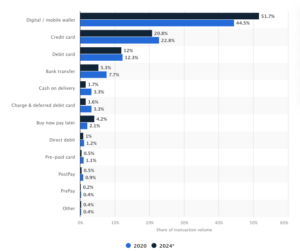Discover how digital wallets are used in Europe – and how they are reshaping commerce.
In the last three years, the transaction value of European digital and mobile payments increased by over 30%. These payment methods are continuing to rise in popularity today, and by 2023 the number of Europeans using cashless payment is set to reach more than 700 million.
Digital wallets are on the ascent in Europe due to consumer preference for digital payments, a desire for easier cross-border transactions and the impending launch of the official European Digital Identity Wallet. It’s only a matter of time before digital and mobile wallets become the preferred online payment methods in Europe.
What is a Digital Wallet?
Digital wallets, also known as ewallets, work by storing and encrypting identification and payment information. By encrypting and verifying this information securely and digitally, customers can pay using their digital wallet – and merchants enjoy lower fraud risk.
With ewallets, there’s no need for customers to enter credit card numbers or search for the right card. Payment becomes as easy as unlocking a mobile phone and can be done online or at the point of purchase in-store.
What are the best mobile wallets for cross-border payments in Europe?
Commonly used digital wallet apps include PayPal, ApplePay, and Samsung Pay. However, the use of digital wallets and the preference for different providers varies widely by country and region.
Among the millions of European digital wallet users, the wallet of choice differs widely by country. Russia prefers YooMoney (formerly Yandex.Money) and Qiwi, iDEAL is a popular digital wallet in the Netherlands, and in Germany, 70% of consumers use PayPal, while Sweden prefers Klarna and Swish. Digital payments are so popular in Sweden that only 13 percent of Swedes paid for their most recent in-person purchase in cash even before the pandemic.
Digital wallets are less common in other regions of Europe. For instance, in the United Kingdom, credit cards remain the preferred form of payment, with 54% of online transactions paid for by card. Similarly, in Russia, over 70% of consumers still use cash as their preferred payment solution.
Regional preferences dictate payment methods, and surprisingly only around 23% of online transactions worldwide are done via credit cards. This number is likely to keep falling as alternative payment methods like bank transfers and ewallets continue to gain popularity. In order to meet evolving consumer expectations and reach new markets, your business must offer its customers the ability to pay using their preferred payment methods.
Graph of Digital and Mobile Wallet Use By European Country

Source: Statista: Share of selected payment methods as a percentage of total ecommerce transaction volume worldwide in 2020, with forecast to 2024.
 Discover the Most Popular Payment Methods in Europe
Discover the Most Popular Payment Methods in Europe
Learn more about how local payment methods and trends are driving sales across Europe.
How to Accept Digital Wallet Payments in Europe
There are hundreds of digital and mobile payments companies doing business in Europe right now, and most customers prefer local options. It’s difficult for companies to navigate this disjointed payment environment, which is why they need a fintech partner like Rapyd to provide seamless access to all customer payment options instead of a patchwork of complex, one-off integrations.
Depending on your exact needs and business goals, Rapyd offers multiple ways to integrate payments into all your sites, apps and stores, including our Collect API, Pre-Built Checkout Hosting and POS solutions and eCommerce Plugins. These solutions let you convert more shoppers everywhere you do business by accepting local and alternative payment methods to scale your company internationally.
Accepting Digital Wallets Is Becoming Essential Across Europe
Globally, digital wallet payment method adoption is projected to exceed 1.3 billion consumers by 2021, with some European markets and the Asia Pacific region leading the way. No matter which European country your customers are from or how large you hope to scale your business, allow them to pay using their desired method, whether it’s by digital wallet, credit card, bank transfer or cash. This flexibility lets you reach vast new markets and ultimately grow sales faster.
Start accepting digital wallets and other locally preferred payment methods worldwide.
Sources Cited:
Central Bank of Sweden (Sveriges Riksbank). “The Payment Behaviour of the Swedish Population.” 2018. https://www.riksbank.se/en-gb/statistics/statistics-on-payments-banknotes-and-coins/payment-patterns/.
Finanso. “Digital Payments in Europe to Surpass $802bn Transaction Value This Year”. 2021. https://finanso.se/digital-payments-in-europe-to-surpass-802bn-transaction-value-this-year/
Fintech News. The number of mobile wallet users grows by 140 million per year. 2019. www.fintechnews.org, https://www.fintechnews.org/the-number-of-mobile-wallet-users-grows-by-140-million-per-year/
Forrester Analytics. “Consumer Technographics® Media And Marketing Recontact Survey.” 2019. https://www.forrester.com/data/consumer/surveys
Statista. “Share of Global Transaction Volume 2020 with projections to 2024.” Statista, Statista, Statista.com. https://www.statista.com/statistics/1111233/payment-method-usage-transaction-volume-share-worldwide/
Statistica. “Mobile payment app use in selected countries in Europe 2019.” 2021. Statista Research Department. https://www.statista.com/statistics/1113874/mobile-payment-app-use-in-selected-countries-in-europe/
Rapyd. “European Payments eBook.” 2020. https://www.rapyd.net/resource/european-economic-profiles-and-opportunities/
Visa. “Annual Digital Payments Study.” 2017. https://s1.q4cdn.com/050606653/files/doc_financials/annual/2017/Visa-2017-Annual-Report.pdf
Photo by Pexels Sam Lion
Subscribe Via Email
Thank You!
You’ve Been Subscribed.



